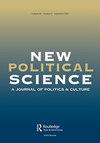Bit Tyrants: The Political Economy of Silicon Valley
IF 0.5
Q4 POLITICAL SCIENCE
引用次数: 5
Abstract
As evidenced by the actions of the United States legislative and executive branches of the last few years, the future of the American economy is being guided by a revived interest in industrial policy and a heightened awareness of the importance of basic and translational research. The 117th Congress was characterized by three enormous industrial and research spending bills. Two were bipartisan: the Infrastructure Investment and Jobs Act (aka the Bipartisan Infrastructure Law) enacted on 15 November 2021, and the Chips and Science Act enacted on 9 August 2022. A third was partisan: the Inflation Reduction Act, enacted on 16 August 2022. While the Trump administration did try to cut research spending in the executive branch budget proposals, the former president ultimately signed budgets passed by Congress that raised scientific research spending at a faster rate than during the Obama administration. The success of Operation Warpspeed in developing COVID-19 vaccines shows the power and potential of federally directed translational scientific research spending and technology implementation. It is unlikely that the divided 118th Congress will change the trajectory of industrial and science policy, and it is difficult to imagine even the most ardent deficit hawk opposing the success of the Chips and Science Act in the face of elevated levels of economic nationalism due to industrial competition with China. Industrial policy, however, comes with the political criticisms that it gives government the power to “pick winners and losers” and gives private sector corporations the ability to take advantage of publicly funded research to build private wealth and power, sometimes to a monopolistic degree. In his book Bit Tyrants: The Political Economy of Silicon Valley, Rob Larson chronicles the monopolistic journey of several big tech Silicon Valley firms (Microsoft, Amazon, Google, and Facebook) and the ongoing battle over net neutrality. While the Silicon Valley firms exert their power in different ways, all four of the firms and their egotistical leaders (the “bit tyrants”) outlined by Larson take advantage of publicly funded research to build their power into a monopoly through business maneuvering and a keen understanding of network effects. Network effects are likely not as powerful in building big tech as Larson believes (Knee 2021), but throughout the book, Larson reiterates that a critical factor that enabled the rise of all the big tech companies is their initial reliance on publicly funded basic research. For example, Larson reiterates both the well-known history of the internet originating out of DARPA and the not-so-known reliance of nearly every component of Apple products on publicly-funded research (e.g., lithium-ion batteries originating out of Department of Energyfunded electrochemistry research). The federal government, through its many alphabet agencies, is great at funding potentially high-risk and low-reward, resource-intensive basic research. For any government, the challenge is not how to fund research, but rather how to assist basic research translate into on-the-ground, meaningful gains for the largest number of people. The solution to this challenge is where I diverge from the author. Larson’s valuable economic analysis of the big tech platforms is let down by his hopeful, yet ultimately disappointing, final chapter calling for socializing internet technology. Indeed, the author does such an excellent job outlining the arguments against internet socialization that his own defense of his call-to-action pales in comparison. Larson points《比特暴君:硅谷的政治经济学
正如美国立法和行政部门过去几年的行动所证明的那样,美国经济的未来正在受到对工业政策的重新关注和对基础研究和转化研究重要性的高度认识的指导。第117届国会的特点是三项巨大的工业和研究支出法案。其中两个是两党合作的:2021年11月15日颁布的《基础设施投资和就业法案》(又名《两党基础设施法》),以及2022年8月9日颁布的《芯片和科学法案》。第三个与党派有关:2022年8月16日颁布的《通货膨胀削减法案》(Inflation Reduction Act)。虽然特朗普政府确实试图在行政部门的预算提案中削减研究支出,但这位前总统最终签署了国会通过的预算,以比奥巴马政府更快的速度增加了科研支出。“Warpspeed行动”在开发COVID-19疫苗方面的成功显示了联邦政府指导的转化科学研究支出和技术实施的力量和潜力。分裂的第118届国会不太可能改变产业和科学政策的轨迹,即使是最狂热的赤字鹰派也很难想象,在与中国的产业竞争导致经济民族主义水平上升的情况下,反对《芯片与科学法案》的成功。然而,产业政策也伴随着政治上的批评,认为它赋予了政府“挑选赢家和输家”的权力,并赋予私营企业利用公共资助的研究来积累私人财富和权力的能力,有时甚至达到垄断的程度。在他的《比特暴君:硅谷的政治经济》一书中,罗伯·拉森记录了几家硅谷大型科技公司(微软、亚马逊、b谷歌和Facebook)的垄断之旅,以及围绕网络中立性的持续斗争。虽然硅谷的公司以不同的方式行使权力,但拉森概述的这四家公司及其自负的领导者(“比特暴君”)都利用公共资助的研究,通过商业操纵和对网络效应的敏锐理解,将自己的权力建立到垄断地位。在建立大型科技公司方面,网络效应可能不像拉尔森认为的那样强大(Knee 2021),但在整本书中,拉尔森重申,所有大型科技公司崛起的一个关键因素是它们最初对公共资助的基础研究的依赖。例如,拉尔森重申了众所周知的互联网起源于DARPA的历史,以及鲜为人知的苹果产品几乎所有组件都依赖于公共资助的研究(例如,锂离子电池起源于能源部资助的电化学研究)。联邦政府,通过它的许多字母机构,在资助潜在高风险和低回报的资源密集型基础研究方面做得很好。对任何政府来说,挑战不是如何资助研究,而是如何帮助基础研究转化为实际的、对大多数人有意义的成果。这个挑战的解决方案是我与作者不同的地方。拉尔森对大型科技平台的有价值的经济分析让人失望,因为他在最后一章呼吁将互联网技术社会化,这一章充满希望,但最终令人失望。事实上,作者在概述反对互联网社会化的论据方面做得非常出色,相比之下,他为自己的号召性行动辩护显得苍白无力。拉森点
本文章由计算机程序翻译,如有差异,请以英文原文为准。
求助全文
约1分钟内获得全文
求助全文

 求助内容:
求助内容: 应助结果提醒方式:
应助结果提醒方式:


